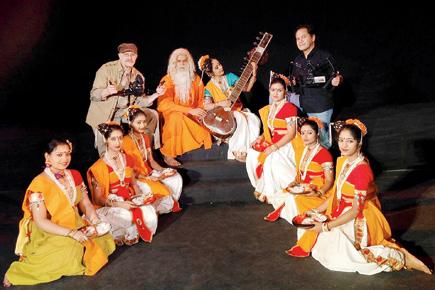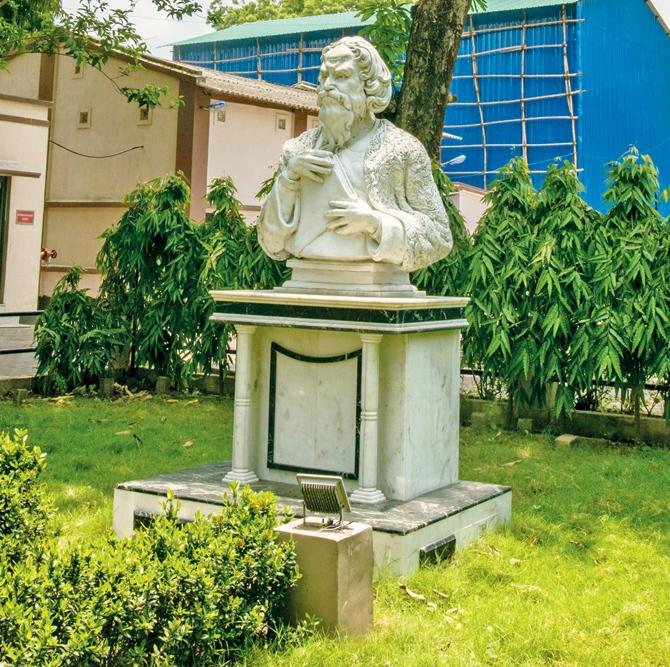US Filmmaker Karl Bardosh's recreation of the Nobel laureate’s film, Natir Puja, after a screening at Cannes this year, is on its way to the Ganges-Danube Cultural Festival

Karl Bardosh with his team on the set in New Theatre Studio
ADVERTISEMENT
Away from the discourse about purple lips and feathery capes at the Cannes film festival this year, there was a small but significant conversation inspired by an Indian legend. A 3D recreation of Natir Puja (1932), the only film Nobel Laureate Rabindranath Tagore ever directed, was being screened for a select audience. The project, titled Natir Puja — The Court Dancer and helmed by US-based researcher-critic-filmmaker Karl Bardosh, is a tribute to the poet-philosopher’s meditations on spirituality, religion and women’s empowerment.

Karl Bardosh with his team on the set in New Theatre Studio
The film has since then been selected for an open-air screening as the Closing Night Event of the Ganges-Danube Cultural Festival (June 17-19) at the Tagore Promenade (where the poet-laureate had planted a tree) at the VESOUL International Asian Film Fest in France. It will be released in Bangladesh next after which it will release in India.
Natir Puja is the dramatic adaptation of Tagore’s epic poem, Pujarini (1899), which is a retelling of a Buddhist legend about court dancer, Srimati, who resists King Ajatshatru’s attempts to re-impose Hinduism on the masses. A part of both his ruminations on Buddhism and his dance-drama oeuvre, it is considered one of the most complex compositions. When cinema legend BN Sircar, founder of New Theatre Studios, approached Tagore with the idea of filming Natir Puja, which was first staged at the latter’s residence in Jorasanko, he decided to film the staged version. Shot over four days at New Theatres, it made a social statement at that time by featuring an ensemble of all-women performers for the very first time. All of them were young students from Shantiniketan. Despite Tagore’s presence (he also acted in it), the film failed to attract audiences. The original film was destroyed in a fire in 1933, though the legend of Natir Puja survived.

Sutapa Awon Pradhan
The central theme — of a social outcast, a woman facing religious intolerance with her unshakable faith in Buddhism — was not easy to dramatise. But it touched a chord with Bardosh, whose first introduction to Tagore was through his Gitanjali while a student at the University of Hungary.
Bardosh was already into cinematic poetry, making shorts that "experimented with philosophical cinematic poetry" while he worked as an "AD and a young director of everyday, garden variety film and television." Once he moved to the US, he began making Poetry Music Videos, in collaboration with the great poet, Allen Ginsberg. "I wrote and produced a Holocaust feature film about the tragic death of Hungary’s national poet, Miklos Radnoti who was shot into a mass grave at the end of a Forced March by the Hungarian Nazis. When they opened the grave after the war they found a notebook in his overcoat pocket with heart-wrenching poems of the Holocaust. This triumph of poetry over war had to be told. Natir Puja has a similar message of the heroine facing death by religious intolerance," he says.

New Theatre in Tollygunje where Natir Puja was shot. Pic/Rana Chakraborty
Bardosh believes we have been thrown back into the dark ages of religious wars. "It takes the genius of a Tagore to conceive a dance-drama based on a 2,400-year-old Buddhist legend to express the tragic timeliness of murder in religious intolerance as a recurring curse on humankind throughout history," he says.

Karl Bardosh
Meanwhile, in 2011, the ICCR, Kolkata, was on the lookout for a creative production that could be staged in neighbouring countries where Buddhism has left its footprints. They reached out to danseuse Sutapa Awon Pradhan, who took up the challenge of adapting Pujarini for the stage. "It was not easy because Pujarini had not been written as a dance-drama. I picked up single-line references to Kali and explored other elements with dramatic potential and elaborated them," says Pradhan. She introduced folk martial dance form of Raibeshe for some segments. The production also featured songs by eminent Rabindrasangeet singer Jayati Chakraborty. The singer feels a strong spiritual connect with Srimati, the martyr-protagonist in the play. "The moment she makes the sacrifice, the complete surrender to her atman, her faith, she is transformed from being a court dancer to a pujarini," she explains. Several verses from Pujarini resonate with this deep spiritual exploration, says Chakraborty, almost like a conversation the poet had with himself. During his research, Bardosh stumbled upon Pradhan’s production at the Satyajit Ray Auditorium of the Tagore Center in Kolkata marking the 150th Birthday of Tagore in 2011. "I wanted to take this to the soundstage at New Theaters where Tagore directed his only film. Thanks to Saugata Nandi, the studio CEO, we did," he says.
Bardosh calls this a film essay.
"Very little is left of the black-and-white original and is in terrible shape so we just used a few seconds as a reference in my film essay. As to the 3D cinematography by documentarist Leonard Retel Helmrich, we used his innovative approach of Single Shot Cinema that made the dance scenes look special. My intention to make this dance drama in 3D was two-fold. I was influenced by Piña, the Oscar-nominated dance documentary by Wim Wenders, and I wanted to be the first one to express Traditional Indian dance in 3D. I also used 3D as a hedge against piracy as the images become unusable upon copying," he adds.
Other collaborators include US-based musician and DJ Satya Hinduja, who composed an original score accompanying Tagore’s own voice singing, dramaturge Gauri Basu, who is the narrator both in the 2011 stage production and in the original film, and Kolkata-based composer Suman Sarkar. It also features conversations with artistes who have performed Natir Puja over the years.
Hinduja, who spent three winter days of 2015 working on the project with Tagore’s "gentle and surreal voice singing" right into her ears, says: "The song Tabu Mone Rekho (Remember Me, sung by Tagore) was clean for me to compose around, but also had a lot of analog crackle and dirt from the recording of that time (1887). It was challenging to engineer out the frequencies that were disturbing the vocal elements and yet keeping the authenticity and clarity of his voice so as to not lose it’s essence. It was so magical to work on artistically for me because capturing the frequencies of that era and reliving it in the now is what made being a part of this project an honour, more than a challenge."
Speaking about the significance of Natir Puja, Bardosh observes how Tagore made this as an educational venture at a time when only commercial cinema existed. "Besides, Tagore made his film in 1932 and it burned in 1933 when Hitler rose to power and the Reichstag was burning. Unbelievable metaphoric parallels with the rise of mass murderers in religious intolerance and racism that Tagore rejected. It was the premonition of brutal religious war by the poet genius." This apart from the powerful message he conveyed by casting middle-class women in the production.
Incidentally, Bardosh had also written and directed in 1992 the first documentary about Indian Cinema for the American Public Broadcasting System. Entitled The World of Film: India with Rita Gam, the former Hollywood star, it was co-produced by Prakash Mehra who got Amitabh Bachchan, Shashi Kapoor and BR Chopra to add heft to the production.
"I was looking for a way to pay tribute to Indian Cinema with a follow-up to my documentary and research, brought me to Tagore’s Natir Puja," he says. "I believe Tagore has a hand in this miracle."
 Subscribe today by clicking the link and stay updated with the latest news!" Click here!
Subscribe today by clicking the link and stay updated with the latest news!" Click here!







